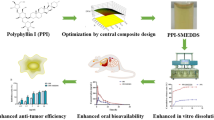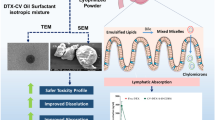Abstract
Pancreatic cancer (PC), currently the third leading cause of cancer-related deaths in the USA, is projected to become the second leading cause, behind lung cancer, by 2020. The increasing incidence, low survival rate, and limited treatment opportunities necessitate the use of alternative approaches such as chemoprevention, to tackle PC. In this study, we report significant synergistic chemoprevention efficacy for the first time from a low-dose combination of a classical antihistaminic drug, Loratadine (LOR) and a neutraceutical compound, Sulforaphane (SFN) using a self-microemulsifying drug delivery system (SMEDDS) formulation. The formulation was developed using Quality by Design approach (globule size, 95.13 ± 7.9 nm; PDI, 0.17 ± 0.04) and revealed significant (p < 0.05) enhancement in the in vitro dissolution profile confirming the enhanced solubility of BCS class II drug LOR with SMEDDS formulation. The LOR-SFN combination revealed ~ 40-fold reduction in IC50 concentration compared to LOR alone in MIA PaCa-2 and Panc-1 cell lines respectively, confirming the synergistic enhancement in chemoprevention. Further, the nanoformulation resulted in ~ 7-fold and ~ 11-fold reduction in IC50 values compared to LOR-SFN combination. Hence, our studies successfully demonstrate that a unique low-dose combination of LOR encapsulated within SMEDDs with SFN shows significantly enhanced chemopreventive efficacy of PC.






Similar content being viewed by others
References
Jemal A, Siegel R, Ward E, Hao Y, Xu J, Thun MJ. Cancer statistics, 2009. CA Cancer J Clin. 2009;59(4):225–49.
Siegel RL, Miller KD, Jemal A. Cancer statistics, 2016. CA Cancer J Clin. 2016;66(1):7–30.
Desai PA, D, Wang, J., Prabhu, S.. Pancreatic cancer: recent advances in nano-formulation based therapies. Critical Reviews™ in therapeutic drug carrier systems. 2018;Forthcoming Article.
Miller MS, Allen P, Brentnall TA, Goggins M, Hruban RH, Petersen GM, et al. Pancreatic cancer chemoprevention translational workshop: meeting report. Pancreas. 2016;45(8):1080–91.
Stan SD, Singh SV, Brand RE. Chemoprevention strategies for pancreatic cancer. Nat Rev Gastroenterol Hepatol. 2010;7(6):347–56.
Patterson SL, Colbert Maresso K, Hawk E. Cancer chemoprevention: successes and failures. Clin Chem. 2013;59(1):94–101.
Sutaria D, Grandhi BK, Thakkar A, Wang J, Prabhu S. Chemoprevention of pancreatic cancer using solid-lipid nanoparticulate delivery of a novel aspirin, curcumin and sulforaphane drug combination regimen. Int J Oncol. 2012;41(6):2260–8.
Thakkar A, Chenreddy S, Wang J, Prabhu S. Ferulic acid combined with aspirin demonstrates chemopreventive potential towards pancreatic cancer when delivered using chitosan-coated solid-lipid nanoparticles. Cell Biosci. 2015;5:46.
Ellegaard AM, Dehlendorff C, Vind AC, Anand A, Cederkvist L, Petersen NHT, et al. Repurposing cationic amphiphilic antihistamines for cancer treatment. EBioMedicine. 2016;9:130–9.
Kirshner JJ, McDonald MC 3rd, Kruter F, Guinigundo AS, Vanni L, Maxwell CL, et al. NOLAN: a randomized, phase 2 study to estimate the effect of prophylactic naproxen or loratadine vs no prophylactic treatment on bone pain in patients with early-stage breast cancer receiving chemotherapy and pegfilgrastim. Support Care Cancer. 2018;26(4):1323–34.
Soule BP, Simone NL, DeGraff WG, Choudhuri R, Cook JA, Mitchell JB. Loratadine dysregulates cell cycle progression and enhances the effect of radiation in human tumor cell lines. Radiat Oncol. 2010;5:8.
Bertl E, Bartsch H, Gerhauser C. Inhibition of angiogenesis and endothelial cell functions are novel sulforaphane-mediated mechanisms in chemoprevention. Mol Cancer Ther. 2006;5(3):575–85.
Liu P, Atkinson SJ, Akbareian SE, Zhou Z, Munsterberg A, Robinson SD, et al. Sulforaphane exerts anti-angiogenesis effects against hepatocellular carcinoma through inhibition of STAT3/HIF-1alpha/VEGF signalling. Sci Rep. 2017;7(1):12651.
Russo M, Spagnuolo C, Russo GL, Skalicka-Wozniak K, Daglia M, Sobarzo-Sanchez E, et al. Nrf2 targeting by sulforaphane: a potential therapy for cancer treatment. Crit Rev Food Sci Nutr. 2018;58(8):1391–405.
Kamal MM, Nazzal S. Novel sulforaphane-enabled self-microemulsifying delivery systems (SFN-SMEDDS) of taxanes: formulation development and in vitro cytotoxicity against breast cancer cells. Int J Pharm. 2018;536(1):187–98.
Hanlon N, Coldham N, Gielbert A, Kuhnert N, Sauer MJ, King LJ, et al. Absolute bioavailability and dose-dependent pharmacokinetic behaviour of dietary doses of the chemopreventive isothiocyanate sulforaphane in rat. Br J Nutr. 2008;99(3):559–64.
Khan MZ, Rausl D, Zanoski R, Zidar S, Mikulcic JH, Krizmanic L, et al. Classification of loratadine based on the biopharmaceutics drug classification concept and possible in vitro-in vivo correlation. Biol Pharm Bull. 2004;27(10):1630–5.
Gautschi N, Bergstrom CA, Kuentz M. Rapid determination of drug solubilization versus supersaturation in natural and digested lipids. Int J Pharm. 2016;513(1–2):164–74.
Huang R, Tan Y, Shen L, Wang T, Quan D. A novel surfactant-free lipid-based formulation for improving oral bioavailability of loratadine using colloidal silicon dioxide as emulsifier and solid carrier. Curr Pharm Biotechnol. 2018;19(3):217–23.
Stillhart C, Durr D, Kuentz M. Toward an improved understanding of the precipitation behavior of weakly basic drugs from oral lipid-based formulations. J Pharm Sci. 2014;103(4):1194–203.
Üner M, Karaman E. Preliminary studies on solid lipid microparticles of loratadine for the treatment of allergic reactions via the nasal route. Trop J Pharm Res. 2013;12(3):287–93.
Desai PD, A.; Patravale V. Overcoming poor oral bioavailability using nanoparticle formulations - opportunities and limitations. Drug Discov Today Technol. 2012;9(2):e71–e174.
Dasgupta S, Mazumder B, Ghosh SK, Kaurav SS. Solid lipid nanoparticles (SLNs) for topical delivery of aceclofenac by using xanthan gum: ex vivo and in vivo evaluation. Curr Drug Deliv. 2012.
Berton-Carabin CR, MH, Genot, C. Lipid oxidation in oil-in-water emulsions: involvement of the interfacial layer. Comprehensive Reviews in Food Science and Food Safety. 2014;13(5).
Mahdi ES, Sakeena MH, Abdulkarim MF, Abdullah GZ, Sattar MA, Noor AM. Effect of surfactant and surfactant blends on pseudoternary phase diagram behavior of newly synthesized palm kernel oil esters. Drug Des Devel Ther. 2011;5:311–23.
McClements DJ. Nanoemulsions versus microemulsions: terminology, differences, and similarities. Soft Matter. 2012;8(6):1719–29.
Mehta SK, Kaur G. Microemulsions: thermodynamic and dynamic properties. Thermodynamics: INTECH Open Access Publisher; 2011. p. 381–406.
Nobel A. Performance blends for emulsification: Akzo Nobel surface chemistry LLC; 2009 [cited 2018 June 15]. Available from: http://www.sc.akzonobel.com/en/agriculture/Documents/Letter_size/AkzoNobel_tb_71_Agro_Emulsion_Performance_Blends.pdf.
Beugin S, Edwards K, Karlsson G, Ollivon M, Lesieur S. New sterically stabilized vesicles based on nonionic surfactant, cholesterol, and poly(ethylene glycol)-cholesterol conjugates. Biophys J. 1998;74(6):3198–210.
Stalidis G, Avranas A, Jannakoudakis D. Interfacial properties and stability of oil-in-water emulsions stabilized with binary mixtures of surfactants. J Colloid Interface Sci. 1990;135(2):313–24.
USFDA. Dissolution methods: USFDA; 2018 [cited 2018 June 15]. Available from: https://www.accessdata.fda.gov/scripts/cder/dissolution/dsp_getallData.cfm.
Gradiz R, Silva HC, Carvalho L, Botelho MF, Mota-Pinto A. MIA PaCa-2 and PANC-1 - pancreas ductal adenocarcinoma cell lines with neuroendocrine differentiation and somatostatin receptors. Sci Rep. 2016;6:21648.
Alkhatib MA-S, D.; Backer, W. Cytotoxic effect of the combination of gemcitabine and atorvastatin loaded in microemulsion on the HCT116 colon cancer cells. Int J Pharm Clin Res. 2017;9(2):146–55.
Chen YC, Chen BH. Preparation of curcuminoid microemulsions from Curcuma longa L. to enhance inhibition effects on growth of colon cancer cells HT-29. RSC Adv. 2018;8(5):2323–37.
Margulis K, Srinivasan S, Ware MJ, Summers HD, Godin B, Magdassi S. Active curcumin nanoparticles formed from a volatile microemulsion template. J Mater Chem B. 2014;2:3745–52.
Funding
This work was supported by the National Institutes of Health [grant num: 1R15CA182834-01].
Author information
Authors and Affiliations
Corresponding author
Ethics declarations
Conflict of interest
The authors declare that they have no conflict of interest.
Additional information
Publisher’s note
Springer Nature remains neutral with regard to jurisdictional claims in published maps and institutional affiliations.
Rights and permissions
About this article
Cite this article
Desai, P., Thakkar, A., Ann, D. et al. Loratadine self-microemulsifying drug delivery systems (SMEDDS) in combination with sulforaphane for the synergistic chemoprevention of pancreatic cancer. Drug Deliv. and Transl. Res. 9, 641–651 (2019). https://doi.org/10.1007/s13346-019-00619-0
Published:
Issue Date:
DOI: https://doi.org/10.1007/s13346-019-00619-0




